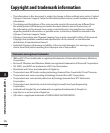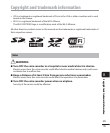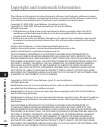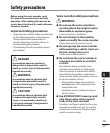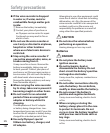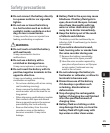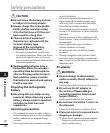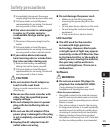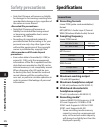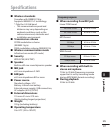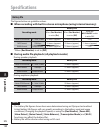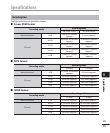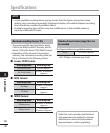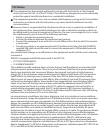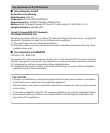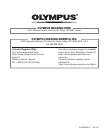
8
126
EN
Safety precautions/Speci cations
Safety precautions
General items
4 Recording formats
Linear PCM (pulse-code modulation)
format
MP3 (MPEG-1 Audio Layer 3) format
WMA (Windows Media Audio) format
4 Sampling frequency
Linear PCM format
48.0 kHz/16 bits 48.0 kHz
44.1 kHz/16 bits 44.1 kHz
MP3 format
256 kbps 44.1 kHz
128 kbps 44.1 kHz
WMA format
32 kbps mono 44.1 kHz
8 kbps mono 8 kHz
4 Maximum working output
150 mW (8Ω speaker)
4 Maximum headphone output
â
1
50 mV (conforms to EN 50332-2)
4 Wide band characteristic
headphone output
75 mV â (conforms to EN 50332-2)
4 Recording media*
Internal NAND FLASH memory: 4 GB
SD card: Supports 512 MB to 2 GB
SDHC card: Supports 4 GB to 32 GB
SDXC card: Supports 64 GB
* Some recording media memory
capacity is used as a management
area, so the actual usable capacity
will always be slightly less than the
displayed capacity.
Specifications
• Note that Olympus will assume no liability
for damages or lost earnings resulting from
recorded data damage or loss, regardless of
the nature or cause thereof.
<Recorded file precautions>
• Note that Olympus will assume no
liability for recorded files being erased
or becoming unplayable due to voice
recorder or PC failure.
• Recording of copyrighted material is
permitted when the recording is for your
personal use only. Any other type of use
without the permission of the copyright
owner is prohibited by copyright law.
<Voice recorder and SD cards disposal
precautions>
• Even when data is formatted (☞ P.88) or
erased (☞ P.46), only the management
information of the file is updated and the
data that was recorded on the SD card or
internal memory is not completely erased.
When disposing of an SD card, be sure
to destroy the card, format the card and
record silence until the recording time
runs out, or perform a similar operation in
order to prevent the leakage of personal
information.



